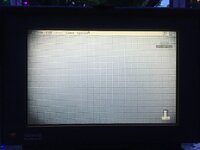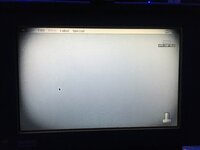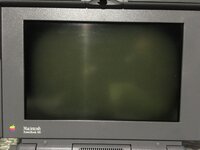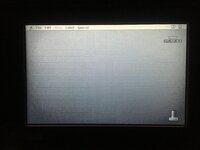I wonder if storing the reassembled & fixed powerbook in a laptop case with a bunch of the silica pouches would keep moisture from being drawn into the lcd - as a preventive measure. With how brittle plastics get, this could prevent the need to ever touch the plastics if adequate moisture never reaches the lcd.
Tunnel vision on PB170
- Thread starter Ron's Computer Videos
- Start date
You are using an out of date browser. It may not display this or other websites correctly.
You should upgrade or use an alternative browser.
You should upgrade or use an alternative browser.
I store my PB170 vacuum bagged in one of those zipped bags for saving wardrobe space, along with one humidity absorbing pouch. You just need to be careful, as vacuum is really powerful and you don’t want to exaggerate with it.
It’s probably not a bad idea to throw a few silica bags under the bezel when reassembling, provided there’s enough room.
Silica doesn’t last forever, it’s much easier to keep the machine in a sealed bag.
Are you sure the internal signal is RGB? Wouldn’t think that would be useful on a greyscale lcd. perhaps on a colour lcd, but even then I’m not so sure.I’m wondering about tying an RGB2HDMI into the monitor port traces internally and replacing the screen with a new flatscreen.
I’m sorry, I thought it had a monitor portAre you sure the internal signal is RGB? Wouldn’t think that would be useful on a greyscale lcd. perhaps on a colour lcd, but even then I’m not so sure.
I recently purchased a Pb 180 and it has the tunnel effect (takes some time to show signs). This seems to be such a common problem for these model Macs, why hasn't anyone created replacement panels?
There's a YouTuber that did this for the TRS-80 Pocket Computer. He sold them for $20 a screen on Tindie (https://www.tindie.com/products/halfbakedmaker/lcd-replacement-for-trs-80-pc-1-sharp-pc-1211 with videos on how he got there) after reverse engineering them and then getting them made in a batch of a few hundred. For the TRS-80 he had to actually re-create the specific LCD panel, whereas for the Powerbooks, the panel is just a resolution specification.
I ended up buying one of his and installed it and it worked great. Hoping someone else with the know-how will eventually do that for, what presumably is, a much larger user base of the Powerbooks:
There's a YouTuber that did this for the TRS-80 Pocket Computer. He sold them for $20 a screen on Tindie (https://www.tindie.com/products/halfbakedmaker/lcd-replacement-for-trs-80-pc-1-sharp-pc-1211 with videos on how he got there) after reverse engineering them and then getting them made in a batch of a few hundred. For the TRS-80 he had to actually re-create the specific LCD panel, whereas for the Powerbooks, the panel is just a resolution specification.
I ended up buying one of his and installed it and it worked great. Hoping someone else with the know-how will eventually do that for, what presumably is, a much larger user base of the Powerbooks:
Last edited:
Sounds great, sign me up for several!I recently purchased a Pb 180 and it has the tunnel effect (takes some time to show signs). This seems to be such a common problem for these model Macs, why hasn't anyone created replacement panels?
There's a YouTuber that did this for the TRS-80 Pocket Computer. He sold them for $20 a screen on Tindie (https://www.tindie.com/products/halfbakedmaker/lcd-replacement-for-trs-80-pc-1-sharp-pc-1211 with videos on how he got there) after reverse engineering them and then getting them made in a batch of a few hundred. For the TRS-80 he had to actually re-create the specific LCD panel, whereas for the Powerbooks, the panel is just a resolution specification.
I ended up buying one of his and installed it and it worked great. Hoping someone else with the know-how will eventually do that for, what presumably is, a much larger user base of the Powerbooks:
So I had an idea. I know that Johann did a video on his YouTube channel, The Basement, where he a) disproved the quick fix method of tightening the tabs, and b) baked the LCD with some success. The quick fix, I believe, came from another YouTuber in an under 5 minute video where he claimed that you could tighten the tabs and that would solve it (he also had a second method of reprogramming the logic chips which seems a bit questionable...dunno).
In any case, that got me thinking about the entire problem. Is it actually a moisture issue or is it just that the layers are coming apart due to failed glue after so many years? If so, then tab-tightening technique could work and when baking, perhaps it is the glue being re-flowed and not the moisture being driven out?! The temperatures listed are in the range of some glues softening, and if the layers are adhered together could that be what fixes it? Leaving it in longer allows the glue to soften more evenly perhaps. What I've seen from some finished pics/videos is that it returns more slightly and not as evenly as before (at least one video where a guy tried this with a different machine).
So if it is an adhesion problem then the technique of tightening the tabs could work as it is pushing the elastomeric strips to the circuit board which pushes back and perhaps presses the panel into the metal bracket forcing the layers to stay together when the panel warms up. Elastomeric strips do have some give (I'm assuming the LCD panel is using elastomeric strips since I haven't taken the panel completely apart). So I gave it a shot the other day and not only further bent the tabs inwards but also tried to get a pair of pliers to hold them firmly and and push the tabs towards the circuit board with a little torque. The screen still darkened but it seemed to have taken much longer and didn't seem to get as bad. Will do more experiments with it in the future. I'm thinking that instead of pliers perhaps a small hammer and pushing the board into the panel with a firm grip and then gently tapping the tabs might yield a tighter result...will see. Not too tight as I don't want to damage the elastomeric strips, which seem (on other devices) to be made of some type of silicon.
In any case, what do people think? Could it be an adhesion problem or has anyone tested specifically for moisture. I know some have said silica and vacuum helps, but then again, vacuum could also press the panel tightly together, re-adhering it for a bit. The fact that someone else said storing the LCD with a ton of silica packets (what I was trying) for half a year in a sealed bag had absolutely no impact just got me thinking, since that ought to drive out some moisture at the edges at least. I guess vacuum sealing it is supposed to squeeze the moisture out...trying to wrap my mind around if that makes sense. Btw, the guy who created the TRS-80 LCD's also tried baking them with no success.
In any case, that got me thinking about the entire problem. Is it actually a moisture issue or is it just that the layers are coming apart due to failed glue after so many years? If so, then tab-tightening technique could work and when baking, perhaps it is the glue being re-flowed and not the moisture being driven out?! The temperatures listed are in the range of some glues softening, and if the layers are adhered together could that be what fixes it? Leaving it in longer allows the glue to soften more evenly perhaps. What I've seen from some finished pics/videos is that it returns more slightly and not as evenly as before (at least one video where a guy tried this with a different machine).
So if it is an adhesion problem then the technique of tightening the tabs could work as it is pushing the elastomeric strips to the circuit board which pushes back and perhaps presses the panel into the metal bracket forcing the layers to stay together when the panel warms up. Elastomeric strips do have some give (I'm assuming the LCD panel is using elastomeric strips since I haven't taken the panel completely apart). So I gave it a shot the other day and not only further bent the tabs inwards but also tried to get a pair of pliers to hold them firmly and and push the tabs towards the circuit board with a little torque. The screen still darkened but it seemed to have taken much longer and didn't seem to get as bad. Will do more experiments with it in the future. I'm thinking that instead of pliers perhaps a small hammer and pushing the board into the panel with a firm grip and then gently tapping the tabs might yield a tighter result...will see. Not too tight as I don't want to damage the elastomeric strips, which seem (on other devices) to be made of some type of silicon.
In any case, what do people think? Could it be an adhesion problem or has anyone tested specifically for moisture. I know some have said silica and vacuum helps, but then again, vacuum could also press the panel tightly together, re-adhering it for a bit. The fact that someone else said storing the LCD with a ton of silica packets (what I was trying) for half a year in a sealed bag had absolutely no impact just got me thinking, since that ought to drive out some moisture at the edges at least. I guess vacuum sealing it is supposed to squeeze the moisture out...trying to wrap my mind around if that makes sense. Btw, the guy who created the TRS-80 LCD's also tried baking them with no success.
You could really be onto something here... My 170 doesn't have any tunnel vision currently, so I can't help test, but we gotta have more people this out! I've read through the entire long 68kMLA thread on the issue started back in 2014 or so multiple times and I don't recall anyone specifically testing for moisture! I might crosspost this on the MLA if you don't mind of course, let me know! More people have got to hear about this!
I did try the tab tightening technique, although the guy posted this method on a Facebook group, same guy though I believe cause he also mentioned the chip reprogramming method. I didn’t see any difference in my testing. But hey it’s worth a shot, the moisture theory is only a theory. I reckon you test it out and report back!So I had an idea. I know that Johann did a video on his YouTube channel, The Basement, where he a) disproved the quick fix method of tightening the tabs, and b) baked the LCD with some success. The quick fix, I believe, came from another YouTuber in an under 5 minute video where he claimed that you could tighten the tabs and that would solve it (he also had a second method of reprogramming the logic chips which seems a bit questionable...dunno).
In any case, that got me thinking about the entire problem. Is it actually a moisture issue or is it just that the layers are coming apart due to failed glue after so many years? If so, then tab-tightening technique could work and when baking, perhaps it is the glue being re-flowed and not the moisture being driven out?! The temperatures listed are in the range of some glues softening, and if the layers are adhered together could that be what fixes it? Leaving it in longer allows the glue to soften more evenly perhaps. What I've seen from some finished pics/videos is that it returns more slightly and not as evenly as before (at least one video where a guy tried this with a different machine).
So if it is an adhesion problem then the technique of tightening the tabs could work as it is pushing the elastomeric strips to the circuit board which pushes back and perhaps presses the panel into the metal bracket forcing the layers to stay together when the panel warms up. Elastomeric strips do have some give (I'm assuming the LCD panel is using elastomeric strips since I haven't taken the panel completely apart). So I gave it a shot the other day and not only further bent the tabs inwards but also tried to get a pair of pliers to hold them firmly and and push the tabs towards the circuit board with a little torque. The screen still darkened but it seemed to have taken much longer and didn't seem to get as bad. Will do more experiments with it in the future. I'm thinking that instead of pliers perhaps a small hammer and pushing the board into the panel with a firm grip and then gently tapping the tabs might yield a tighter result...will see. Not too tight as I don't want to damage the elastomeric strips, which seem (on other devices) to be made of some type of silicon.
In any case, what do people think? Could it be an adhesion problem or has anyone tested specifically for moisture. I know some have said silica and vacuum helps, but then again, vacuum could also press the panel tightly together, re-adhering it for a bit. The fact that someone else said storing the LCD with a ton of silica packets (what I was trying) for half a year in a sealed bag had absolutely no impact just got me thinking, since that ought to drive out some moisture at the edges at least. I guess vacuum sealing it is supposed to squeeze the moisture out...trying to wrap my mind around if that makes sense. Btw, the guy who created the TRS-80 LCD's also tried baking them with no success.
Sure, feel free to crosspost.You could really be onto something here... My 170 doesn't have any tunnel vision currently, so I can't help test, but we gotta have more people this out! I've read through the entire long 68kMLA thread on the issue started back in 2014 or so multiple times and I don't recall anyone specifically testing for moisture! I might crosspost this on the MLA if you don't mind of course, let me know! More people have got to hear about this!
Yup, I got that from your informative video. The one difference is that I didn't just twist the tabs but also tried to torque them towards the board to get a more snug fit, pressing the LCD between the metal bezel and the circuit board. It seemed to help a bit with screen lasting longer and more slowly crawling towards tunnel....from 30 minutes to 90 minutes. It's hard to say since it may depend on other factors, although our house is AC'ed at 78 degrees. The technique may only work so much but just the curiosity of what the issue is.I did try the tab tightening technique, although the guy posted this method on a Facebook group, same guy though I believe cause he also mentioned the chip reprogramming method. I didn’t see any difference in my testing. But hey it’s worth a shot, the moisture theory is only a theory. I reckon you test it out and report back!
I've read so many misleading things on this. Especially people summarizing what they read. For instance, there was one person that said that they saw that the screen actually gets better if you leave the machine on longer. The only instance I found was from a blog where the person had said their machine went to sleep (or whatever the equivalent is for 90's PowerBooks) and when they returned it was back to normal...that is not the screen getting better when on, that's just the screen resetting. So lots of confusing info out there.
I've been experimenting with my Powerbook 180. The pictures below are after I opened up the screen and torqued the convectors at the corners of the circuit board towards it (so 2-3 on each side...not just twisting them vertically but also horizontally). Outside temp in mid 70s.
The first picture is after 90 minutes with screen constantly on. Second is after an additional 90 minutes but with screen blanked (didn't seem to make a difference as image still deteriorated). I then turned machine off for 120 minutes and the screen in off still looks pretty bad. However, upon turning it on, it doesn't translate to the picture (that part is weird).
My next step is to remove the LCD again and this time press down on circuit board and tap all the tabs with a small hammer to evenly fit the screen as snuggly as possible between the elctromeric strips and the bezel to see if it improves it further (same time test).
Note that I do have a video of me using the machine originally and after 30 minutes it was worse than the 90 minute image today.
The first picture is after 90 minutes with screen constantly on. Second is after an additional 90 minutes but with screen blanked (didn't seem to make a difference as image still deteriorated). I then turned machine off for 120 minutes and the screen in off still looks pretty bad. However, upon turning it on, it doesn't translate to the picture (that part is weird).
My next step is to remove the LCD again and this time press down on circuit board and tap all the tabs with a small hammer to evenly fit the screen as snuggly as possible between the elctromeric strips and the bezel to see if it improves it further (same time test).
Note that I do have a video of me using the machine originally and after 30 minutes it was worse than the 90 minute image today.
Attachments
My 170 screen is still sitting on my to-do pile as I follow this discussion. Interested if baking is now not worth the trouble.
Ok, finally was able to do my tap test. It failed. I tried twice, the second time, while firmly pushing down the circuit board to the bezel, I tapped pretty rigorous with a small hammer. Any harder would not have been wise. The screen still showed signs after 45 minutes. Is it less bad? That is so hard to put a finger on as it depends perhaps on heat (82 degrees both times) and humidity (not in AC'ed place).
So what's the next step? Perhaps baking can still be a solution. I still think it's not about moisture but about adhesion and that baking may be re-flowing that part...if that's the case is also means that it could last a bit longer than just driving moisture out.
Again, all just a theory so if anyone better informed knows it to be moisture I wouldn't disagree with enough evidence. I did have high hopes that a tighter fit would do the trick. The first time it looked really good after about 20 minutes, with no signs, but it did then creep in after an hour. There are liklely no elecrtomeric strips all the way round and the bezel has not clips on the side it fails first...so should have known.
I did create a video of the experience to come out sometime this summer...just was hoping it would be successful :-/
So what's the next step? Perhaps baking can still be a solution. I still think it's not about moisture but about adhesion and that baking may be re-flowing that part...if that's the case is also means that it could last a bit longer than just driving moisture out.
Again, all just a theory so if anyone better informed knows it to be moisture I wouldn't disagree with enough evidence. I did have high hopes that a tighter fit would do the trick. The first time it looked really good after about 20 minutes, with no signs, but it did then creep in after an hour. There are liklely no elecrtomeric strips all the way round and the bezel has not clips on the side it fails first...so should have known.
I did create a video of the experience to come out sometime this summer...just was hoping it would be successful :-/
This is the “typical” condition you would see lcd screens looking like on auctions in Japan.
Summers here get awfully humid and hot.
Put “time” into the equation, and the result is that most of vintage laptop panels are gone.
Is it about delamination or is it because of humidity? Or is it something else?
Honestly, I guess we would need a specialist of this very kind of technology for having an answer.
From my side, I can only confirm I’ve been fairly successful in mitigating the tunnel effect by storing the PB170 in a vacuum bag with humidity absorbing pouches for a long, long time. By now, I’m talking about *years*.
On the contrary, though, storing them in very careful and controlled conditions could not prevent 2 of my 3 Portables from developing dead rows of pixels.
Very disappointing, but I guess we have to cope with the idea that our beloved vintage equipment was designed, engineered and tested for lasting just a bunch of years.
By comparison, cars are designed for lasting 10 years, human body up to 80 (and with great damage accruing along the way).
The image you showed was vinegar syndrome - when the display polarizer adhesive fails. You can replace the polarizer to fix that issue, but it's tricky.
Whatever, it‘s just for showing a severely compromised lcd panel in a similar pattern. That stuff just deteriorates, it was not designed to last forever. Amen.The image you showed was vinegar syndrome - when the display polarizer adhesive fails. You can replace the polarizer to fix that issue, but it's tricky.




